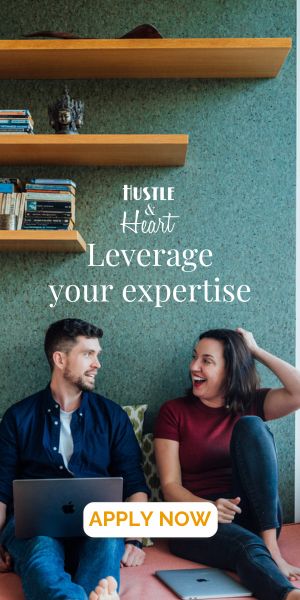(This article was updated November 2023.)
You know there are a limited number of hours in the day, there’s only one of you, and you’re not getting any younger (just kidding! You’re looking fabulous!).
You’d like to sell your services online. You’d like to create an online course and reach people, regardless of their geographical location.
But it’s in the too-hard basket, right? It’s doesn’t have to be so! In this article, we talk about how to create your online course, quickly and with as little angst and over-thinking as possible.
Begin at the beginning
The lean business or start-up business model is a great one for solopreneurs to adapt because we don’t have excess resources to spend developing big courses supported by big marketing budgets. We sometimes have to be keenly lean.
Before you go creating your course, you want to test the waters. You want to determine, as best you can, whether it’s something people will buy. You want to avoid spending a lot of time, effort and funds building an online course with hope as your marketing strategy.
Your social media communities, where you’ve been cultivating relationships, are perfect to test out your ideas. Having listened closely to your ideal clients and heard their frustrations, worries and struggles, you’ve got a few course ideas.
So put it out to your social media community as an A, B or C affair. Make it easy for them to vote on which idea they prefer.
Some of their issues will be big, medium or small. Some they will happily pay to solve (or minimise) and some are issues they can tolerate for longer. You want to be selling the former.
Next, put up a simple preliminary sales page with a sign-up form, for collecting email addresses of people who want to be notified when it’s ready (this is crucial!). Promote this page through all your usual online outlets – email, social media, and when one-to-one with people.
Writing your course
Having determined, as best you can, which idea will work and starting to collect emails of interested prospects, you then write your course. Start with a one-page overview that chunks down the main ideas and puts these into a logical sequence.
Then you’ve got the hardest part: determining what to put in and what to leave out. You don’t want to overwhelm people, because overwhelmed people don’t make good students.
Chuck down all your course content to no more than 20-30 minutes to consume. There’s noting wrong with using checklists or ‘printables’ to help summarise your main points and enable people to more easily retain what you’ve taught.
What format?
The second hardest part of creating online courses is determining format – this is because we put the cart before the horse. Rather than letting our creative right brain have free rein of the e-course ideas and materials, we allow our critical left brain to interrupt the party too early with bothersome questions about technology.
Technology is an enabler, not the main event. Technology is the medium, not the message.
Shut down your critical brain for as long as you can, until you’ve nutted out the course materials, then think about which format suits.
At the least, you need Google Drive, Zoom and your email marketing software (see recommended tools and resources).
You also need to decide whether to release all course materials as instant-access training or to send it out (over a series of days, weeks or months). Also to be determined are whether you’re going to start the course on a particular date so that everyone goes through it together, possibly with some live calls with you in the chair, or make it available as “evergreen”, to start at any time?
There are pros and cons for both. There’s no surefire way. Go with what works best for yourself, your business and your clients.
Online course software
Don’t go to town now. Unless you’ve got significant funds to invest, you don’t have to go all fancy on us.
If you’ve got a WordPress websites, it’s fairly straightforward to create a bunch of password-protected pages to host your e-course materials on. No, you don’t even need a plugin for this.
At a minimum, you’ve set up an email auto-responder with a series of communications set to go out that introduces each lesson and links to where the online course materials are hosted. (See recommended tools and resources).
Start with simple. Run your first online course, run it again and again, refine and shine, and upgrade thoughtfully, with the profits you’ve earned.
Keep your eyes on the task at hand
Your brilliance lies in your content – not in whether it comes out on a Tuesday or Wednesday, uses video or involves a webinar or three. Don’t get derailed by overwhelm, anxiety and arguments over the finer details of how it’ll be delivered. This is a distant second to your primary task of delivering value that your clients will happily pay good money for.
Keep your eyes on the prize – getting deep into the heart of the problem and helping people to solve it.
They’re paying for your insights, wisdom and guidance through overcoming their issues, whether those are having troubling getting to sleep or staying asleep, managing their stress and anxiety over raising young children or teenagers, communicating more effectively with their partner and experiencing greater relationship satisfaction, dealing with chronic back pain, managing diabetes, or overcoming lack of concentration and focus.
There are countless issues and problems that you can help with. This is your value. Don’t get distracted or deterred by the minutiae.
Keep your delivery simply. Save your time, attention and heart for the content.
Marketing alongside creation
When you’re 75 per cent of the way through your course creation, start marketing in earnest. Return to your preliminary sales page and turn it into a proper sales page. Spend three quarters of the page talking about the issues, worries, or problems you’re solving and the outcomes and benefits of your course. Spend the final quarter of your page talking about the format, the price and your terms and conditions.
Remember, if you’re planning to sell this online course over and over and over (which is where the profit comes in), you’ll need to be marketing seriously and consistently. You’ll need to keep driving traffic to your opt-in or sign-up page. In time, you may consider creating a free mini-course as a pre-launch warm-up to your paid course.
You’ll need to get out there and grow your network and meet people with their own networks with whom to collaborate and promote with.
But for goodness sake, start. Start today. Don’t get deterred by the sophisticated, complicated technology, the for-and-against, the competition. Don’t get distracted. Don’t give up.
Start with the problem worth solving. Focus on the content. Get going. The world needs what you have.
It’s time to launch.





